Do-it-yourself decorative plaster on a wall for a beginner. Required skills and where to get them. We use mineral granules
A finishing material such as decorative plaster is not cheap, nor are the services of a professional to apply it. Of course, it all depends on the type of material, manufacturer, chosen texture and desired effect. But the basic principles of operation are the same in all cases and differ little (if you look at it in a simplified way). Therefore, you can always learn how to apply it yourself decorative plaster. It will take many hours of practice to perfect this art, though again, it all depends on the desired effect and the chosen material. It will be easy to work with one solution, but nothing will work with another, no matter how hard you try.
Types of decorative plaster
Without going into details, it is worth dwelling on the types of decorative plaster. It is necessary to understand what kind of material this is, because the selection of tools and the application of decorative plaster itself depend on this.
This is what coatings made with Venetian, textured and structural plasters look like, respectively.
- Venetian plaster is sold in the form of a thick plastic mass. Often it is translucent, but I use it to imitate natural stone(mostly marble). It refers to mineral plasters, which use crumbs or flour of various minerals as a filler. Using the Venetian, smooth surfaces are created. The main role in working with such material is played by the application technique.
- Textured plasters are presented in the form of a thick, homogeneous mass with plastic properties. The material is applied in an even layer, and then the texture is formed using various devices. Such mixtures are most often used to create intricate surfaces, because they are easy to work with. Working tools play a key role when working with such material.
- Structural materials contain various granules. It is this filler that plays a decisive role in creating the desired surface. These granules form grooves and hollows when applied.
Methods for applying decorative plaster greatly depend on what fillers are used in the solution. It is one thing to work with cement-based plaster and quite another to use polymer-based silicone solutions. However, if you delve into this issue, you can get to the point where you have to describe the intricacies of working with many varieties of decorative plasters from different manufacturers. For a beginner, the division into textured, structural and Venetian decorative plasters will be quite enough.
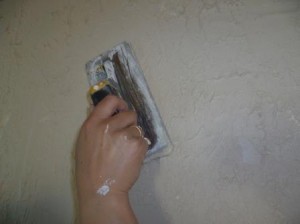 Various tools and techniques are used to create different effects.
Various tools and techniques are used to create different effects. Everyone's favorite simple budget putty belongs to textured materials. A plastic solution based on gypsum is applied in an even layer, and then the desired texture is created using various devices.
Scope of application and difficulties encountered
Do-it-yourself decorative plaster can be applied indoors and outdoors. If we are talking about facade finishing, then in the vast majority of cases structural materials are used for these purposes. They don't cost much, but the decorative effect won't be as beautiful as it could be. It's quite suitable for the façade. We are more interested in interior decoration, where people use decorative plaster for its intended purpose - not only to decorate walls, but also to create a unique atmosphere that will please the eye.
Where in the apartment can decorative plaster be applied?
- In the corridor and hallway it is best to use structural mortars with fine-grained filler. The smaller the filler, the more beautiful the pattern will be. Such materials have increased wear resistance and can withstand mechanical loads well.
- Decorative plaster finishing of ceilings can be done using Venetian. This is the best option, since the ceiling is already perfectly smooth, which is a necessary condition for simulating natural materials. The coating can be protected with varnish and wax, which will save it from moisture in the kitchen and bathroom.
- If Venetian is suitable for the ceiling of the kitchen and bathroom, then it is not necessary to use it for the walls, because it will be too expensive. Textured materials are ideal for the walls in these rooms.
- The bedroom and children's room can be decorated with both textured mixtures and Venetian. This is a matter of taste and financial capabilities.
- In the hall, due to its large area, structural plaster with a fine texture looks good.
- The columns must be finished with Venetian so that they become “marble”. You can do the same with arches, but you need to think about the transition between the arch and the wall.
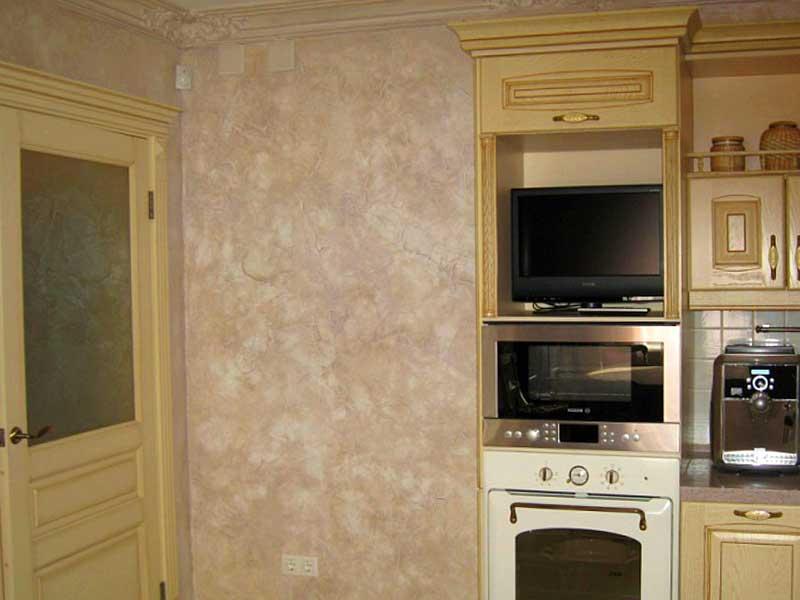

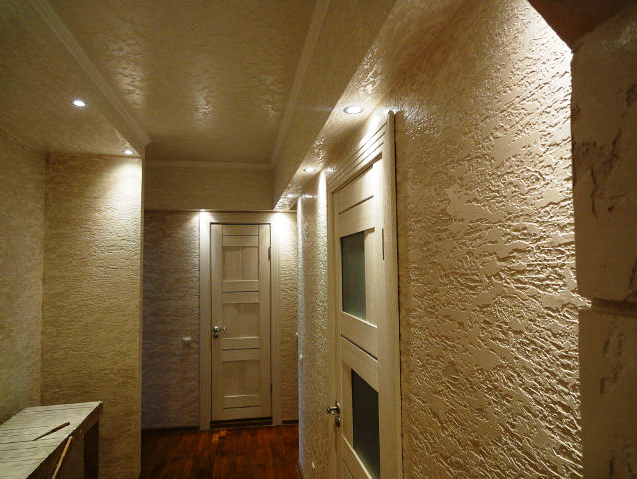

Knowing where exactly the decorative plaster will be applied, you will understand what material you need. And after that you can study all kinds of application techniques.
What tools might be useful?
The following tools may be required for work:
- Metal trowel. It is necessary for any work, and you cannot do without it. The trowel should be made of stainless steel. Otherwise, after some time, rust may appear on the finished coating. To work with the Venetian, a special Venetian trowel is used.
- Putty knife. Another essential tool. It should be small in size so that it is convenient for them to collect the solution from the bucket. Using a spatula, the solution is applied to the trowel in the required amount, and then the trowel is transferred to the wall. Sometimes a wide spatula is used to replace a trowel.
- Plastic grater. It is mainly used when working with structural decorative plaster. It is used to smooth the surface, catching the granules contained in the solution. As a result, a “bark beetle” (“lamb”) texture is formed.
- The brush is used when working with textured mixtures. With its help, various roughness and swirls are created.
- Roller. Decorative plaster is sometimes applied using a regular roller. After this, the material is smoothed with a grater, creating a decorative coating. So, a roller is rarely used; more often it is used to roll over an already applied solution to form a coat.
- Textured roller and stamps. Using a stamp or textured roller, similar patterns are created on the wall.
- Decorative plaster is rarely applied with a spray gun, but such a tool can come in handy.
- Other devices. This includes applicators, sea sponge, crumpled cellophane, a foam roller covered with a rope and other tools that are used extremely rarely or are created independently. All of them are used only when working with textured decorative plaster.
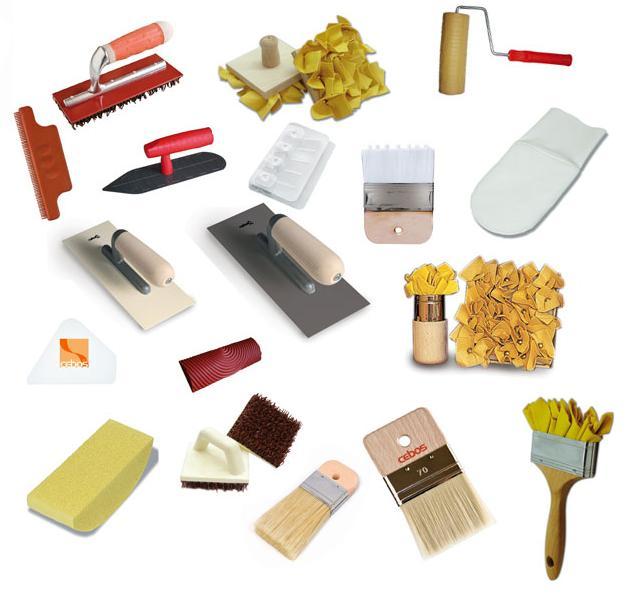 For various works use different tools
For various works use different tools It is also worth mentioning that not all mixtures are sold ready-made, and some of them will have to be prepared yourself. To do this, you will need a plastic container and a drill with a mixer attachment. Even if the solution is sold ready-made, its color is usually white. After adding the toner, the mixture will need to be mixed. This can be done with a trowel, but for greater efficiency you should use a mixer.
Required skills and where to get them
You can't do without working tools. Some you will need to buy, but some you can do yourself (only relevant for working with textured mixtures). But even if you have the right tools at hand, you can’t do without skills. Where can I get them to know how to apply decorative plaster? You can go to a master class, but it costs money, and each master has his own opinion and is used to working with certain products. You can read information materials and watch video lessons, and then try to bring everything to life.
Whatever path you take, you will have to act at your own peril and risk. Therefore, we recommend purchasing the material with a reserve so that part of it can be used for training. You will also need to buy several pieces of plywood on which to hone your skills. When the technology for applying decorative plaster has been perfected on a plywood board 2-3 times, you can proceed to practice on the wall. You will already have an idea of how the whole process works in reality. Here you will learn only the general features of the work, because it is simply impossible to consider all aspects at once.
Final touches before application
You already know where you want to use decorative plaster, and what kind of material you need. You now have a rough idea of the tools needed and what type of decoration they are suitable for. You could proceed directly to application, but you will have to wait a little. The work surface can make all the difference.
 The thinner the layer of decorative plaster, the smoother the surface should be.
The thinner the layer of decorative plaster, the smoother the surface should be. In most cases, the decorative material is applied in a thin layer, which means that all the unevenness of the wall will be visible through it. Therefore, the working surface must be clean and smooth, free from dents, chips and cracks. In the case of the Venetian, the wall must be brought to a perfectly smooth state.
Then a layer of primer is applied. It is important to select soil depending on the type of solution. It is advisable that the decorative plaster and primer be produced by the same manufacturer. Then the best effect from their interaction will be achieved.
The primer is a light liquid that is used for better adhesion between the working surface and the applied coating. In other words, the primer acts as the glue that makes the solution stick to the wall and not fall off.
Application technique in general
The technique of applying decorative plaster greatly depends on the selected product. Therefore, we will focus on three large groups: structural, textured and Venetian plasters. Let's look at them in general outline, and if you need more detailed information, then in the “Effects” section of the site all the nuances of the work on creating specific patterns and drawings are described in detail. The “Manufacturers” section contains detailed recommendations for applying decorative plaster of various brands. Next, generalized information will be presented that will be useful for beginners to form a general impression of the work.
Structural plasters for the most inexperienced
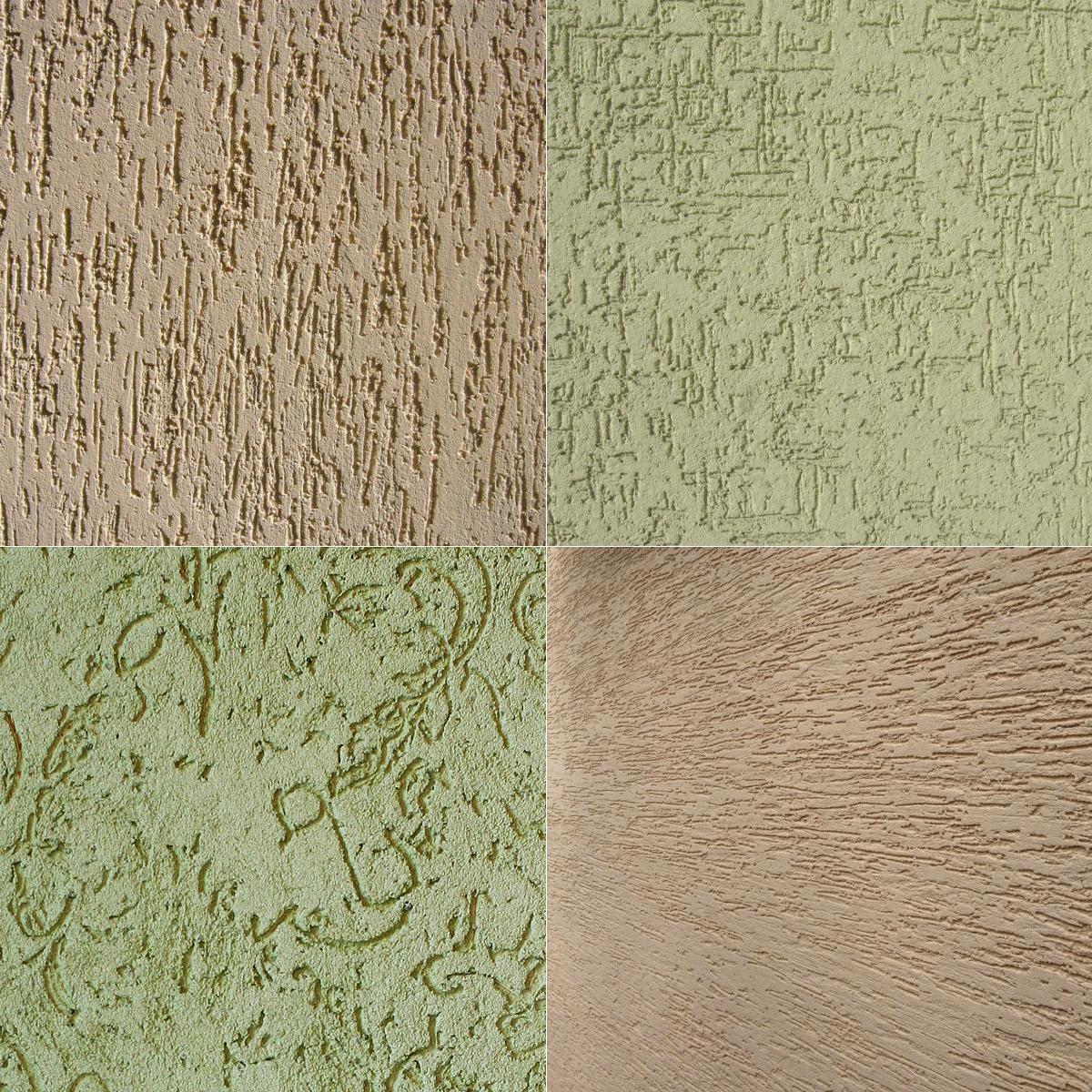 “Bark beetle” made using different techniques
“Bark beetle” made using different techniques Structural plaster is applied in a layer, the thickness of which should be comparable to the grain size of the filler (written on the packaging). After this layer begins to harden, it begins to be smoothed with a plastic grater. The movements can be horizontal, vertical, circular or cross. You should start working with a grater after the surface stops sticking to your hand.
River sand, quartz, mica and other minerals can be used as a filler for structural plaster. This affects the cost of production, and also slightly on appearance finished surface.
You can run the grater over one place for as long as you want. If you don’t like the drawing, you can change the direction of movements and see what happens next. This application of decorative plaster does not seem difficult, so anyone can cope with this work.
Textured plasters for people with imagination
The textured solution is also applied to the wall in an even layer using a trowel. However, you can form the texture immediately after applying it or wait until it begins to dry. If you work right away, you can walk over the liquid solution with a regular roller to create a fur coat. Or simply press the entire surface of the trowel against the wall, and then tear it off, pulling the mortar onto yourself. The essence of these methods is to “pull” the solution from the wall in any way. Then you need to wait until the material dries and smooth it with a smoothing iron or trowel.
The same patterns can be created in other ways. You can apply one even layer and wait for it to dry completely. And then scoop up the solution onto the entire surface of the trowel and, using light touches, transfer it to the wall in various places. We wait for the solution to dry and rub it with a trowel in different directions. The result will be a coverage known as a world map or islands.
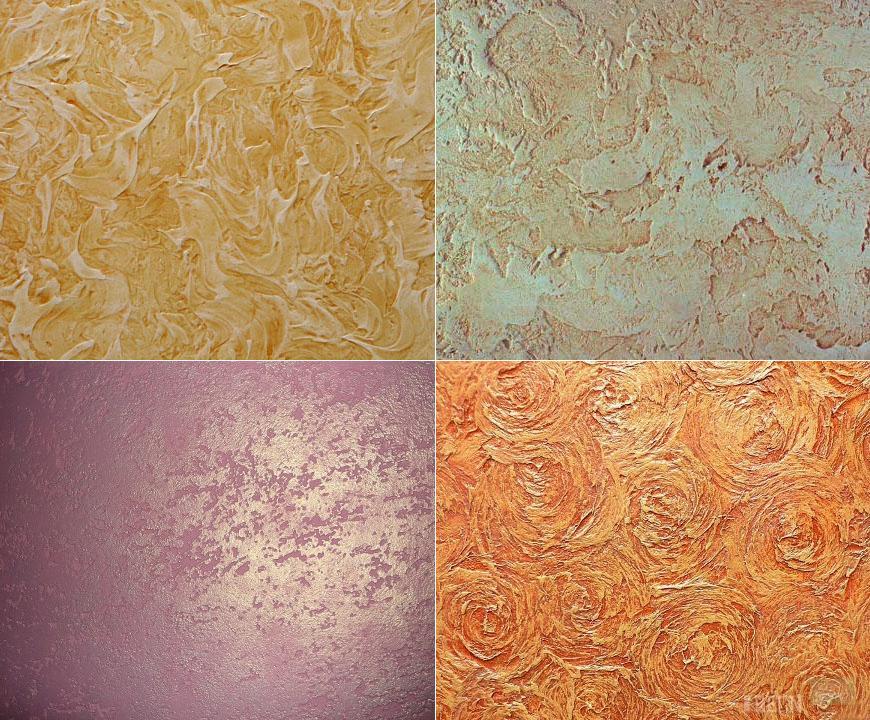 The decorative effect is greatly enhanced by painting the surface
The decorative effect is greatly enhanced by painting the surface As a result of applying textured decorative plaster using various techniques, the following effects can be obtained (the list is not complete, this is only a small part of the possible options):
- Travertine.
- Wave.
- World map.
- Boulders.
- Fur coat.
- Tree.
- Crinkled fabric.
The dried coating can also be treated with textured rollers. These tools already have an imprint on the work surface, allowing you to create a pattern on the wall. These patterns will be of the same type, but working in this way is very simple. You need to roll the roller along the wall and the pattern is ready. There are many techniques and methods for working with textured mixtures, but describing them would take too much time.
Venetian for experienced craftsmen
If you have never worked with mortar before, it is better not to start with the Venetian. Its decorative effect is simply excellent, but the cost is too high, and the technique is complicated. You will need to level the surface to a perfectly flat and smooth state, which can already be a challenge for a beginner. The application of Venetian decorative plaster is carried out using the trowel of the same name “to scratch”. This means that the layer of applied material should be as thin as possible.
 Ironing, waxing and sanding create a glossy finish
Ironing, waxing and sanding create a glossy finish There should be 2-5 layers in total to achieve the desired effect. To make the coating more decorative, it is necessary to work with several colors or shades at once on each layer of coating. In this case, a beautiful shimmer and depth of color will be created. It is highly advisable to iron the finished coating (pass it over the dried coating with a trowel under pressure many times to create a gloss). After this, the coating will need to be varnished or waxed (this can also be done “by stripping” or using a special sponge). Then there will be a polishing process using a grinding machine. A mistake at any stage will ruin the appearance of the coating.
In conclusion, it is worth summarizing the most important things. Venetian plasters are expensive and very difficult to work with. Structural materials are created with a “bark beetle” texture. They are not expensive, they are easy to work with, but the decorative effect may not be beautiful enough. Textured materials are the most suitable in terms of price to quality ratio. You can always experiment with them, use your imagination and create unique coatings.
Decorative plaster for walls is a wonderful environmentally friendly and moisture-resistant material. There are many ways to apply it to a surface, each of which can give a unique design depending on the flight of imagination of its author. Let's look at some of them. To work you will need the following:
- decorative plaster;
- paint grater;
- putty knife;
- primer;
- rollers;
- paper;
- textile;
- brushes;
- polyethylene film;
- sponge;
- stencils.




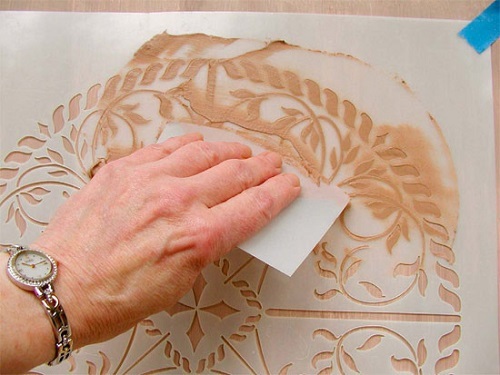

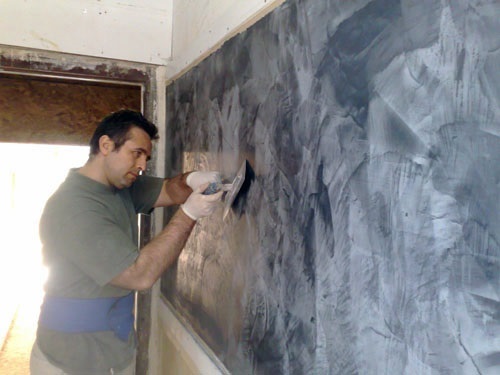
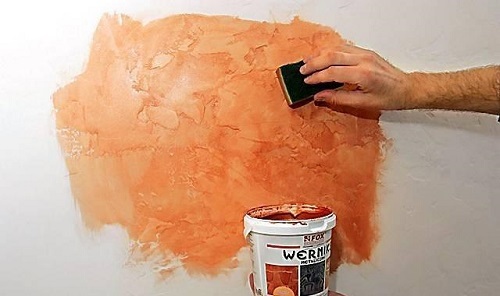
This is all. Good luck with your work!
In this article we will talk about ways to apply decorative plaster with your own hands. The process itself is not complicated, but it will require your attention and accuracy. Well, first things first...
Method 1
Applying decorative plaster to walls with your own hands. Sequence of work
Today, a great variety of different wall finishing options have been developed, but decorative plaster has earned particular popularity and love due to its combination of aesthetics and ease of application. Applying decorative plaster with your own hands will not require enormous effort or special experience (although you may have to practice). In addition, when you finish finishing the walls, you can clean them with detergents without fear of water or these substances damaging the finish.
Thus, plaster is one of the most practical options for wall decoration. If you do everything correctly, the plaster will serve you for many years without requiring repair or restoration.
How to choose decorative plaster
Choosing plaster is a very important stage, but it is not particularly difficult. Plaster can be classified in different ways. For example, depending on what kind of surface you get at the end of the work, or on the method of applying the coating. And if with the second characteristic everything is more or less clear (having heard “roller” in relation to finishing, you will understand that the plaster is applied with a roller), then let’s dwell on the types of surfaces in a little more detail.
So, decorative plaster can be:
1. Structural. If you are offered “structural plaster” in a store, this means that special granules have been added to the paste, which, in fact, is any plaster. For example, pebbles or wood fiber - depending on what surface this finish imitates.
2. Flock. This type implies that tiny multi-colored grains will be placed on top of the glue.
3. Venetian. This is one of the most luxurious types of plaster, which is made using marble flour. As a result, your wall will look like marble.
4. "Semi-antique." Realistic imitation of “scuff marks”.
In most cases, decorative plaster is a homogeneous paste with the addition of a certain pigment, which gives it color. However, when choosing plaster, think about whether you want a smooth wall or prefer an unusual texture. In principle, you can create a spectacular relief using ordinary plaster, but it is much easier to initially buy so-called textured plaster. If in the first case you will need to create the relief manually, then in the second you simply apply the plaster to the wall in an even layer.
The base of the plaster is also important. Based on what is included in the base, all decorative plasters can be divided into the following types:
- Mineral. This is a very fireproof material, which is usually used for exterior decoration.
- Acrylic. This is one of the most common types of plaster, which is most often used for finishing residential premises.
- Silicate. There is an opinion that this type of plaster can be harmful to health, so it is better not to purchase silicate plaster for your own home, even though silicate material is the easiest to apply.
How to prepare a surface for decorative plaster
Like any other finishing work, the application of plaster begins with the surface of the walls being prepared for further processing. This is done as follows.
If there is old finish on the wall, it must be removed and then the surface must be thoroughly washed to ensure the wall is as clean as possible. When the surface is dry, take sandpaper and carefully level the wall: there should be no irregularities left on it. Please note that both applying the plaster and preparing the surface should take place at a moderate room temperature: it should not be too cold or too hot.
After cleaning and leveling the wall, the surface must be coated with a primer, which will provide better adhesion between the wall and the decorative plaster. If there are any elements on the wall that could cause rust, such as dowels, they should be insulated - otherwise the rust will penetrate into the wall covering
How to apply decorative plaster
Once you have prepared the surface, you can proceed directly to applying the plaster. Applying decorative plaster to walls with your own hands requires following the instructions that come with the material. Carefully read the manufacturer's recommendations before starting work.
You need to dilute the plaster correctly (only if it is not silicate - this plaster is sold ready-made, but, as we have already said, it is better not to apply it in residential premises).
Plaster is applied to the walls using a stainless steel spatula or a plastic trowel. The choice of application tool depends on what the material manufacturer recommends.
Please note: when working with decorative plaster, you cannot use steel tools, otherwise rusty marks will inevitably appear on the surface of the wall.
Approximate list of tools required for applying plaster:
- Container in which the mixture is diluted .
- Spatulas (trowels).
- Ironing iron.
- Painting tape - you can use it to protect surrounding surfaces.
- Roller or mitten for application.
- A damp cloth - you will use it to clean your instruments
- Wax - they need to coat the plaster after finishing the job to make the coating more durable.
- Gloves.
Before you begin applying plaster, turn off all heating appliances. If the room is very hot, the plaster will harden too quickly, which means it will be difficult for you to work with it.
Do not leave the can of material open throughout the entire work. This is necessary so that the material does not lose its properties, and also in order to protect the plaster from debris or excess moisture getting into it. The correct method for applying plaster will be indicated on the packaging - a lot depends on what kind of plaster you have chosen.
The packaging with the material should also indicate the drying time of the plaster. The work can be corrected, but only until the plaster hardens. As soon as this happens, any attempts to change something will cease to produce results, on the contrary: by running a tool over a dried surface, you risk damaging the plaster and completely ruining your own work.
Most often, decorative plaster is applied using a trowel or spatula, and then leveled using a roller.
If you chose textured plaster with fine grains, you will need a spray gun to apply the material to the wall. Don't forget to cover nearby surfaces with masking tape, otherwise you'll get them dirty. In addition, make sure that the plaster is applied in an even layer. The thickness of the layer can be a couple of millimeters, or even more. Apply the material continuously, without pauses.
There is another way. The prepared solution can be sprayed onto the wall using a stick and a broom. However, don’t be discouraged if you fail to apply the plaster correctly the first time using this method. You can either practice spraying it on another surface, or use the easier first method.
How to give plaster texture
If you initially chose the so-called textured plaster, then the relief on the wall surface will appear by itself, without additional effort. But you can create a spectacular relief of the wall surface without the help of special materials. So, if you apply the material with infrequent, broad strokes, the wall will turn out visually smooth, but small “strokes” using a spatula will give the wall a more original and interesting look.
To get an unusual grooved surface, you can use a special grater, or you can give it a relief with the same spatula. It is better to do this together with an assistant: one applies a fairly thick layer of plaster, and the second immediately forms the texture before the material has time to harden.
Plaster is very plastic: it can be given almost any shape - the main thing is to practice first, because this procedure requires experience. Please note that if this is your first time working with this material, or if you have no experience and have undertaken to do not the usual smooth finish, but a textured one, then you most likely will not be able to achieve the desired effect the first time. So you need to practice on cardboard first to get a beautiful relief.
Drying speed of decorative plaster
The drying time for this finish is several days. More exact time depends on the type of mixture, its composition and manufacturer. The time required for the material to dry completely must be indicated on the packaging.
In a couple of days the plaster will dry and you can touch the walls without any problems, but complete drying will only occur after a week or so.
Method 2
Is it possible to make decorative plaster with your own hands without experience and without knowing what materials are used for finishing? An ordinary person who decides to make renovations in his own apartment with his own hands will have an unequivocal answer. Of course, it’s difficult to make such decoration as in the photo (I’m not talking about the masters), but if you really want, for example, to make an unusual decoration of the walls in the kitchen or in the hallway, but you’re pretty tired of the wallpaper, what should you do?Most often, the person who started the renovation is not a specialist in decorative plaster, and even more so does not know what materials are needed, for example, to apply Venetian plaster, or in what sequence to carry out all the operations.
So, let's begin. What materials you need: putty (Turkish “satengips”), fugenfüller (for sealing seams in drywall), primer (in principle, you can use any), paint (for example, triora No. 7, or choose one suitable for painting decorative plaster), color for paints (what color is needed here, choose that color), glaze (Trior company with the “silver” effect). Everything according to the materials.
By tool: drill with a mixer (for stirring the putty), a pair of spatulas large and small (for applying the mixture), a trowel with rounded corners (for forming the structure of the decorative coating), a grater with sandpaper (for leveling the plaster), two rollers with a large and fine lint (for painting), a sponge (for applying glaze), well, that’s it, more details on tools for painting.
On the walls: in principle, with this method of applying decorative plaster there is no need to particularly prepare the walls, since the decorative layer will be relatively large and can hide all small unevenness. But, of course, if the walls are very uneven, then it is better to level them. The main preparation is priming, that is, before applying decorative plaster, we prime the walls.
So, we have prepared the materials and tools, let’s begin: mix the putty and fugenfüller in a bucket in a ratio of approximately 1:1. Instead of fugenfüller, you can use rodband or isogypsum plaster, but in this case the structure will be a little rougher than when using a mixture with fugenfüller.
Next, apply a layer of putty approximately 2-4 millimeters thick to the wall with a regular spatula. By quadrature, let’s say, as much as the mixture is mixed, apply that much at a time, well, usually with such a layer it turns out to be from 4 to 6 square meters, that is, half of a small wall can be immediately sealed.
The next stage is the formation of the structure. There are many ways and it is not necessary to use a trowel; you can go over the applied layer of plaster with a regular sponge or sponge roller, for example, you can buy a special roller to form the structure of decorative plaster. There are many ways, but if you want to do something unusual, you can simply try, for example, on a piece of drywall, creating your own method of decorative plaster, especially since you can find many samples of ready-made decorative plaster on the Internet.
So, we form a structure with a trowel, doing it this way: we lightly press the trowel to the plaster, and as if we are trying to “tear” it from the wall. With such movements we go through the entire layer of putty, slightly short of the end of the layer, about 2-3 centimeters - this is necessary so that after applying the next layer of putty, when forming the structure, there are no visible seams at the joint of the plaster.
We smooth the resulting structure with circular movements of the trowel - try it experimentally: if you don’t like the design in some place, we make the structure as described above and smooth it. At least 20-30 minutes before the plaster begins to dry, so there is time.

We applied the structure, corrected it in some places (as without this, after all, for the first time), we wait until it dries. Usually, at normal summer temperatures, it will dry the next day, after which further processing can begin.
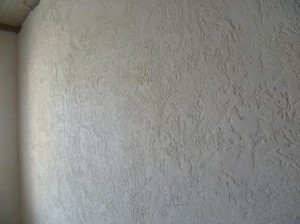
Unpainted wall decoration with decorative plaster looks approximately the same as in the photo. I repeat once again - this is one of the methods of decorative plaster that can be done with your own hands without large material costs.

When painting, we immediately apply the background with a long-haired roller to paint over the structure. A beige background was used in the photo.

Next, use a short-haired roller to apply the main layer of paint, that is, the short hair prevents the paint from covering the main background. It turns out that the background paints over the recesses of the plaster, and the main paint paints over the top.
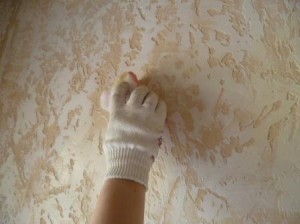
We wait for the paint to dry for about 30-40 minutes and proceed to the final processing of the decorative plaster with glaze.
A few words about glaze. In the photo, glaze with a “silver” effect was used, slightly tinted in beige color.
The glaze is applied with a sponge. There is nothing complicated here, the main thing is not to make omissions.

Well, your DIY decorative plaster is ready. Try it: there are a lot of options and ways to decorate walls, the main thing is to use your imagination, and, we hope, this article was able to help you with the difficult repair.
Photo from the site: legkovmeste.ru
Many people today decide to postpone renovation work own home until better times, considering that all this pleasure would be prohibitively expensive, taking into account the cost of materials, as well as the work of professional craftsmen. However, everything is not so expensive if you try to do some stages, or even all the repair work, with your own hands, involving your family in such useful activities. For example, it will be quite easy to apply decorative plaster yourself; the main thing here is to understand the essence of the work, and the video will help to finally explain all the subtleties and nuances if at least something remains a mystery to you.
General features and points

Photo from the site: remont-dacha.ru
The most beautiful, artistic types of plasters can really be expensive, especially if your own skills are not enough. However, you can learn the process of applying decorative plaster on your own, and with a little practice, you can do a really decent job, turning your home from a typical average apartment into something special, where living will be pleasant, comfortable and easy.
Applying decorative plaster with your own hands is not an easy process, nor is it quick at all. Almost all mixtures for creating decorative artistic plaster set quickly, in just three to five hours. However, in order for such a finish to dry completely, you need to wait much longer. Preliminary drying occurs in about 36 hours, and final drying only after five to ten days.
It makes sense to first study all the recommendations and advice that professionals give, and only then figure out how to apply decorative plaster, in order to be able to take everything into account at once and then not correct the mistakes made. First, decide on the compositions that you will use, since the entire final result will depend on this in the first place.

Photo from the site: stroychik.ru
- It is inconvenient to work with an excessively liquid mixture, as it will constantly flow, forcing you to return several times to the same place, which will significantly lengthen the repair time.
- For the first time, it is better to choose materials that are not dangerous to health and life, that is, that do not have toxic properties. The most neutral can be considered mixtures that are diluted with water, and not with special solvents. But even in this case, it will not hurt to use a protective suit, gloves, a respirator and goggles.
- If the selected plaster has a fairly large stone or cracks as a filler, then it will have to be applied exclusively by hand, but a variety of textures and different sizes the filler will require machine application. These criteria will help you figure out how to apply decorative plaster on walls in the easiest way.
- All porous materials will necessarily absorb some of the moisture from the plaster mixture, but smooth ones will not. That is, plaster on concrete, brickwork and even clay base will dry much faster than applied to a plastic, polyurethane foam or painted surface.
- If you have a wooden base, for example, boards, MDF, chipboard or fibreboard, OSB or plywood, then you need to be prepared for the fact that water-soluble compounds can lead to its deformation.
- When plaster has to be placed on metal objects, they can be affected by corrosion, and stains are quite capable of appearing on the surface of the plaster layer. Therefore, it is advisable to first coat the metal parts with an anti-corrosion coating, and only then figure out how to properly apply decorative plaster to the walls.
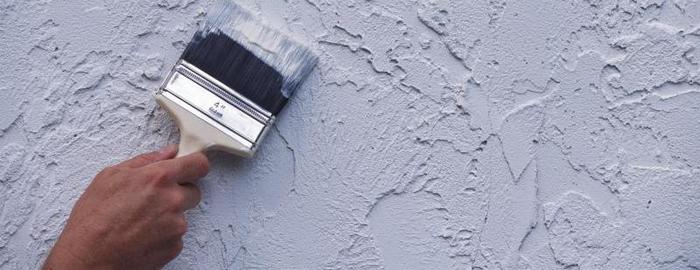
Photo from website: hauzdecor.com
It doesn't hurt to know that uneven surfaces will require more material to be applied, which can make the repair much more expensive. Therefore, it makes sense to pre-level the walls with cheaper mixtures, for example, cement and sand. Thus, we answered one more question, is it possible to apply decorative plaster on plaster, and the answer is affirmative. However, before proceeding, it is advisable to wait until the preparatory layer has completely hardened.
Preparing the wall for plastering
Applying decorative plaster with your own hands is not a simple process at all. preliminary preparation there is no way to cope with the walls, as the video fully demonstrates. The surface must remain clean and dry, free from dirt, dust, remnants of old mortar and other things. There shouldn’t be any large cracks or greasy stains visible, otherwise they will appear on your fresh work, ruining the whole thing and forcing you to start all over again.

Photo from the site: Bouw.ru
But even after the complete process of cleaning, preparing and leveling, decorative plaster can be applied to the wall with your own hands only after it has been thoroughly primed. Many people underestimate the role of primer, and it’s completely wrong. It will significantly increase the adhesion of any composition to the surface, prevent the development of fungi and mold if it contains fungicides, strengthen and strengthen the load-bearing layer (base), prevent the walls from becoming damp, and prevent deformation from external factors.
Modern industry offers many types and types of primers, among which you need to choose only one that is most suitable. You need to choose it according to the composition and type of wall base. For crumbling and fragile surfaces, such as old plaster or drywall, you should buy deep-penetrating primers, but for concrete or brickwork, surface compounds will suffice.
Ways and methods of applying decorative plaster
So, decorative plaster has been chosen as the main coating, but you still don’t know how to apply it correctly? This is exactly what we're talking about we'll talk, and we won’t offer you anything complicated. For example, true Venetian plaster can only be done correctly by a highly professional craftsman; it takes a very long time to do, because sometimes you have to apply from four to ten layers to achieve the desired effect.
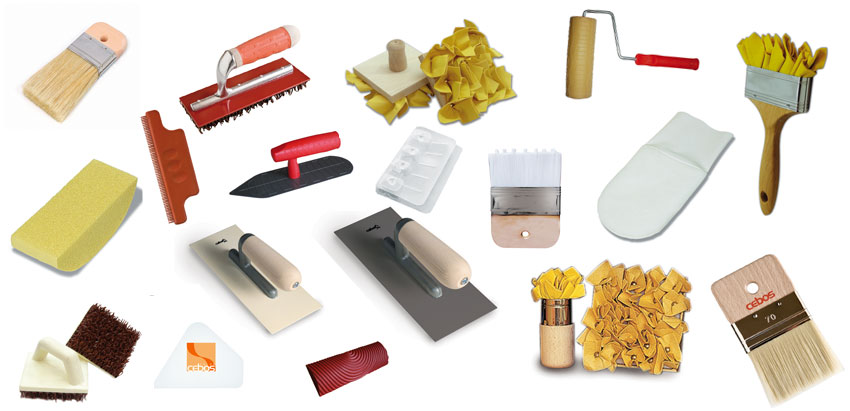
Photo from the site: stroite-sami.ru
There is a way to get around such “stumbling blocks” and figure out how to apply decorative plaster in a simplified form, and the video will allow you to understand all the intricacies of the process. To begin with, it’s tedious to prepare the necessary tools that you will need to make artistic plaster with your own hands:
- Trowel or trowel for applying the composition. Some people use a special plastering machine, but it is hardly affordable, and indeed necessary, to the common man that he is not going to deal with this matter professionally.
- Various swing brushes.
- Curly rollers with different textured patterns.
- Spatulas, graters and spatulas, both metal and plastic, used for final finishing.
Many craftsmen generally use the most unusual means at hand to create a special wall texture. For example, it could be a crumpled plastic bag, a rag, a piece of paper, tape, a broom and other items that it’s hard to think about that they could be useful in such a matter. The main thing to remember is that the trowel for “pulling” the plaster is always held at an angle of sixty degrees, and you need to move exclusively from the bottom up.
Application of the notorious bark beetle

Photo from the site: myshtukaturka.ru
If you are planning to make the famous popular bark beetle at home, you should first figure out how to apply decorative plaster on the walls, and the video will help you find out in detail. Essentially, the mixture contains various granules or crumbs, which, with the right technology, leave grooves and grooves on the finishing layer. In fact, there is nothing complicated, if you get used to it, you can do everything quite quickly.
- First, the plaster mixture is applied to the surface of the wall; you can cover a fairly large area at a time, this will be easier and faster.
- After you finish applying the composition to the wall, you need to start working with a float from the place where you started, but wait a few minutes so that the mixture becomes more viscous. The easiest way to learn how to apply decorative plaster with your own hands is from the video below.
- To get a uniform surface with randomly located grooves, you need to move the grater in a circular motion, but make sure that they are directed exclusively in one direction.
- If you want to make longitudinal, transverse, radial or cross grooves, then the movements must be performed accordingly.
The excess mortar, most likely, will not contain the stone that is responsible for creating the pattern, will have to be thrown away immediately, it is no longer suitable for anything, except to repair the hole. A simple and accessible master class on applying decorative plaster such as bark beetle can be seen in the video, then there will definitely be no secrets left for you.
Fur coat and spraying technique
Another fairly popular method of applying decorative plaster to walls is shown in the video below and is simply called a fur coat. This technology is incredibly simple, so even a beginner can cope with this work. The wall must be prepared for application, and most importantly, it must be primed very well, otherwise chipping and peeling cannot be avoided, which is quite difficult to correct later. You can make a “spray” or fur coat using two main methods.

Photo from the site: NashaOtdelka.ru
- To work, you will need a mesh with cells of about a centimeter by centimeter, as well as a large swing-type paint brush. By vigorously shaking the solution from the brush onto the wall through the mesh, you will obtain the required texture. You will have to work hard, and you need to monitor the effort, otherwise the drawing will turn out to be uneven.
- The second option, how to properly apply decorative plaster using a regular broom, is exactly what is shown in the video. Here everything is even simpler, and to work, in addition to a broom, you will need an ordinary stick or plank. Scoop the solution onto a broom, and then apply it to the wall by hitting the broom against a stick or plank.
Alternatively, you can vary the thickness of the solution. For example, if you make a more liquid composition, then when applied in this way, you can get a surface with a texture reminiscent of flakes of various shapes and sizes. As you can see, there is nothing complicated, and an elementary master class on applying decorative plaster is available on video, which will definitely help you cope with the task without any misunderstandings.
Plastering with a textured roller and improvised means
Applying decorative plaster with a roller having a certain texture is also simple and accessible, and there are many options for such tools on the market. If you don’t have time or opportunity to go shopping, then you can create it at home, or you can even use improvised means, such as a sponge, rags, plastic bags and other items. But let's start with how to act using a roller.

Photo from website: FB.ru
- Prepare the plaster solution; it should have a fairly liquid consistency, otherwise it will be very difficult to work with a roller, and it’s unlikely that you’ll get the texture you want.
- Dip the roller into the composition and slowly but surely, using sliding and smooth movements, distribute the plaster over the entire area of the wall, starting from the bottom.
- If there are already some decorative elements on the walls, or you don’t want to touch the ceilings, it makes sense to cover it all with masking tape.

Photo from the site: syl.ru
You can regulate the pattern, its intensity and frequency, by the speed of your movements, as well as by the pressing force. Do not use textured mixtures on their own for rollers of this kind, but rather apply them to the walls with a smooth tool. Such compositions take shape on their own, and you can only disrupt this process. It wouldn’t hurt to watch a video about applying decorative plaster with a roller, which will explain all the intricacies of the work in order to avoid surprises.
All this is good, but you shouldn’t forget about the means at hand. Simply by applying plaster to the wall, you can leave traces of a sponge, a crumpled plastic bag, a rag and the like on it, which, after hardening, can also acquire an attractive and unusual shape. Conventional paint brushes with thick and thin, hard and soft bristles are also used. This way you can form waves and protrusions, boulders, strokes, shading and similar textures.
Once you see a room whose walls are decorated with decorative plaster, you will surely be seized by the desire to build such beauty in your apartment. And then show it to your friends and acquaintances, incredibly proud that you did it all with your own hands. There is a desire, all that remains is to find out how to properly apply decorative plaster on the walls with your own hands so that your rooms, and perhaps individual rooms, are different from most other standard apartments. Trying to understand the secrets of craftsmanship, let's take a closer look at all the subtleties of decorative plaster.
To begin with, let’s not take risks and take as an experiment a small part of the room, for example, one wall in the room, which is an original design solution. Let's try to decorate the wall with decorative plaster.
Before starting work, it would be a good idea to carefully read the information presented in this article, including video materials. From them you can learn about the technology of applying plaster, what materials and which manufacturers are best to buy, and what tools should be used.

Having enriched yourself with knowledge, you should rush to the store to get the necessary materials building materials. You need to choose the material slowly, in consultation with the seller. Having weighed everything and calculated, you can buy the source material, as well as the necessary tools.
By the way, the main tool for carrying out the work will be a trowel, which is a steel or plastic spatula equipped with a comfortable handle.
Now let's talk about the plaster itself. It's usually sold in an 8kg bucket with "texture paint" written on it. The plaster is produced in white color, and if there is a need to give the plaster a certain shade, then you should buy the desired color. Experts advise using Tikkurila; such paint is not cheap at all.
Thus, to finish a wall with an area of 3 sq. m on average will cost about one and a half thousand rubles, while decorative plaster costs 400 rubles per 8 kg, and if you buy a cheaper color, you can make a pretty decent coating at an affordable price. It should be based on flow rate 1-2 kg per 1 sq. m, depending on the thickness of the layer.
The first step in applying decorative plaster will be thinning the plaster; this must be done in accordance with the instructions indicated on the packaging. Plaster can be sold ready-made. According to the recommendations, the wall should be pre-primed, which will ensure more reliable adhesion of the plaster to the surface. Then, using a narrow spatula, a layer of plaster is applied to the trowel. Then, using a trowel, apply a thin 1-3 mm layer of plaster to the wall and level the surface.
By following this technology, you can cover any surface with decorative plaster. With such a decorative finish you can do whatever you want, because the plaster has high ductility and can accept various shapes. Among other things, using a nap roller you can give the plaster a different texture. Then smooth it out a little with a spatula. Instead of a roller, sometimes an ordinary sponge is used.
In other words, you can give decorative plaster a particular look using your fantasy and imagination. A wonderful texture is obtained if you use a brush and apply broad strokes with it. To give the plaster a special texture, simple spatulas, figured rollers, and notched spatulas are also used. Sometimes plaster is applied in two layers.
There is also plaster that contains marble chips. When applied with a regular spatula, you already get a rather interesting texture in the form of chopped wood. This type of plaster is called.
We will do it simpler - take a narrow spatula and give the necessary relief with smooth and wave-like movements. Decorative plaster will look original and unique.
After 24 hours, even a thick layer of plaster will dry, all that remains is to paint the coating in the desired color, matching the color of the wallpaper and harmonizing with the interior of the room. The paint will adhere properly if applied with a sponge or roller. Another way to add color to the coating is by tinting the plaster - diluting it with paint in a certain ratio. This option is considered more practical and of higher quality.
Among the many ways to decorate rooms, decorative plaster is a fairly new and modern method that can give your apartment originality and freshness.
DIY decorative plaster of walls: sea foam effect. Video
Another way to add an original texture to decorative plaster is the effect of sea foam. To do this we need two plastic spatulas: one large and the other small. We take the finished mixture onto a large spatula and level it with tangential movements. As a result, we should get a drop-shaped state of the plaster. Now we carefully apply the plaster spatula to the wall, thereby transferring these droplets to the wall.
After 15 - 20 minutes, you can begin to smooth out the drops. We take a small spatula and smooth out the droplets without effort, wiping the spatula with a clean cloth each time. That's it, we have a sea wave texture.
Decorative plaster. Application instructions. Video
Another video about the use of decorative plaster. Complete instructions with examples of wall texturing, after looking at which you can easily finish the walls with your own hands. Good luck to everyone, make your premises beautiful and unique!



















